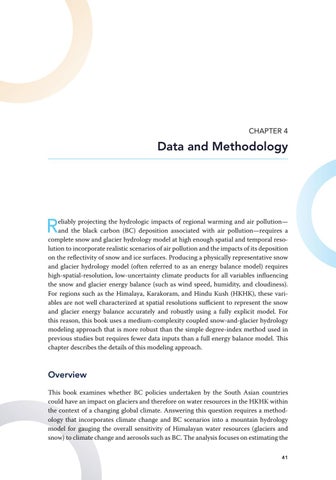CHAPTER 4
Data and Methodology
R
eliably projecting the hydrologic impacts of regional warming and air pollution— and the black carbon (BC) deposition associated with air pollution—requires a complete snow and glacier hydrology model at high enough spatial and temporal resolution to incorporate realistic scenarios of air pollution and the impacts of its deposition on the reflectivity of snow and ice surfaces. Producing a physically representative snow and glacier hydrology model (often referred to as an energy balance model) requires high-spatial-resolution, low-uncertainty climate products for all variables influencing the snow and glacier energy balance (such as wind speed, humidity, and cloudiness). For regions such as the Himalaya, Karakoram, and Hindu Kush (HKHK), these variables are not well characterized at spatial resolutions sufficient to represent the snow and glacier energy balance accurately and robustly using a fully explicit model. For this reason, this book uses a medium-complexity coupled snow-and-glacier hydrology modeling approach that is more robust than the simple degree-index method used in previous studies but requires fewer data inputs than a full energy balance model. This chapter describes the details of this modeling approach.
Overview This book examines whether BC policies undertaken by the South Asian countries could have an impact on glaciers and therefore on water resources in the HKHK within the context of a changing global climate. Answering this question requires a methodology that incorporates climate change and BC scenarios into a mountain hydrology model for gauging the overall sensitivity of Himalayan water resources (glaciers and snow) to climate change and aerosols such as BC. The analysis focuses on estimating the 41




